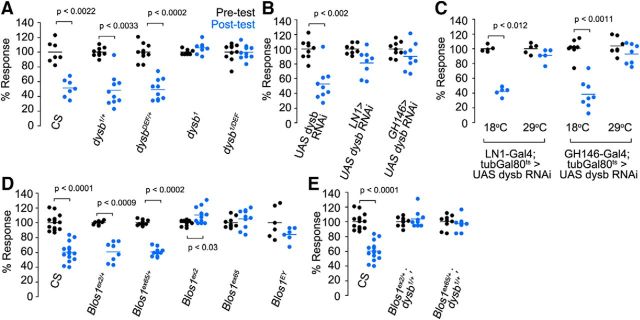Figure 7.
BLOC-1 is required at LNs and projection neurons for short-term olfactory habituation in Drosophila. Following aversive odor exposure, control (Canton S, CS) or single-copy loss-of-function (dysb1/+, dysbDF/+) animals show significant avoidance behavior, represented as % Response, compared with pre-exposure response (A, compare blue dots to black). dysb mutants (dysb1 and dysb1/Df) show no learned avoidance following aversive odor exposure. B, Specific expression of dysbindin RNAi in either the LNs (LN1 driver) or projection neurons (GH146 driver) is sufficient to prevent normal postexposure avoidance response. C, Inhibition of dysbindin RNAi expression in the LNs or the projection neurons using the temperature-sensitive repressor tubGal80ts at the permissive temperature (18°C) allowed for normal olfactory habituation. Repression of tubGal80ts at the nonpermissive temperature (29°C) led to impaired odorant-avoidance response. D, Blos1 homozygous mutations but no single-copy loss prevent learned odorant-avoidance behavior. E, Blos1 mutations expressed in trans with dysb1 prevent learned odorant-avoidance response. Dot plots represent independent experiment per genotype. Comparisons were made with Wilcoxon–Mann–Whitney test.

